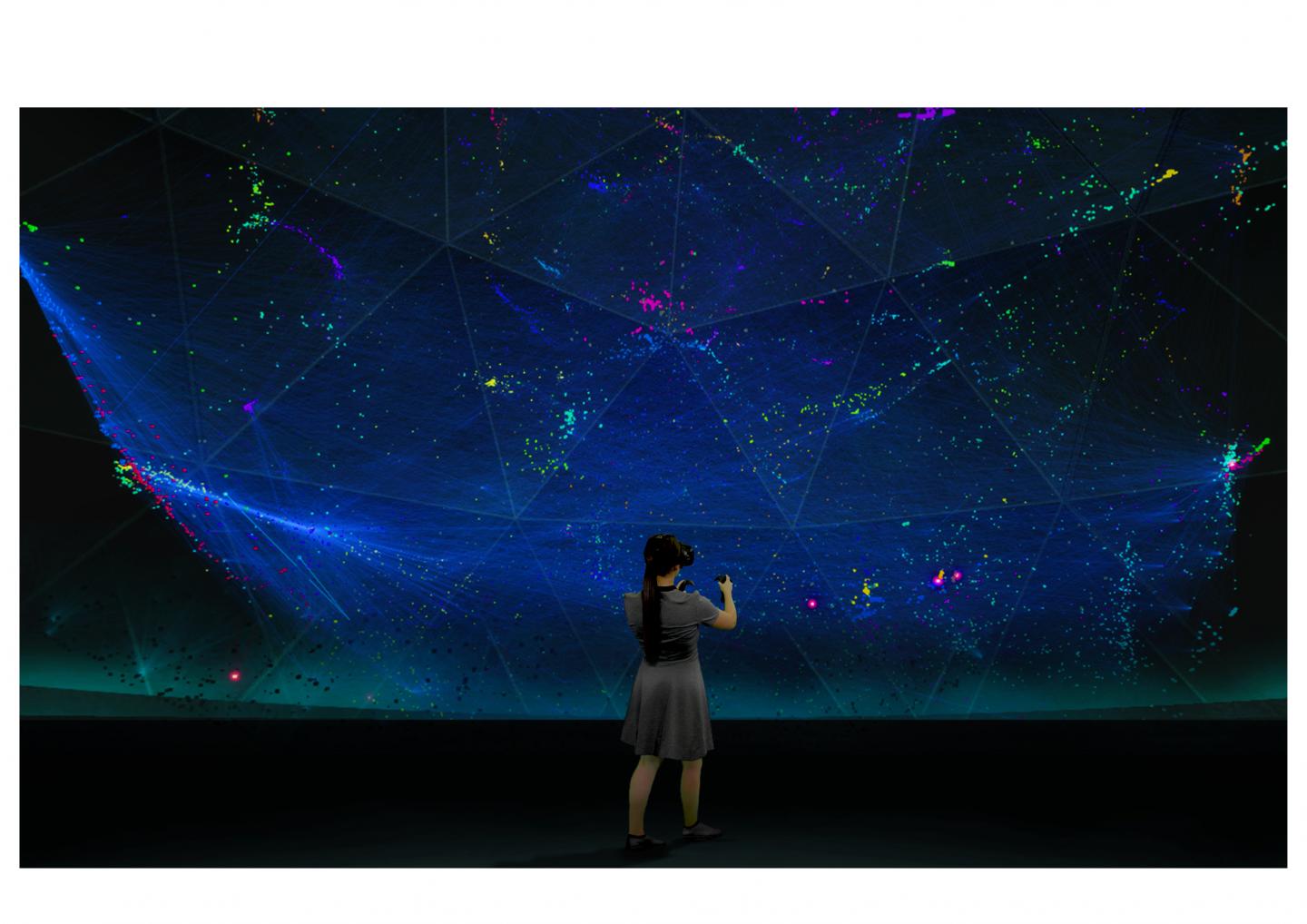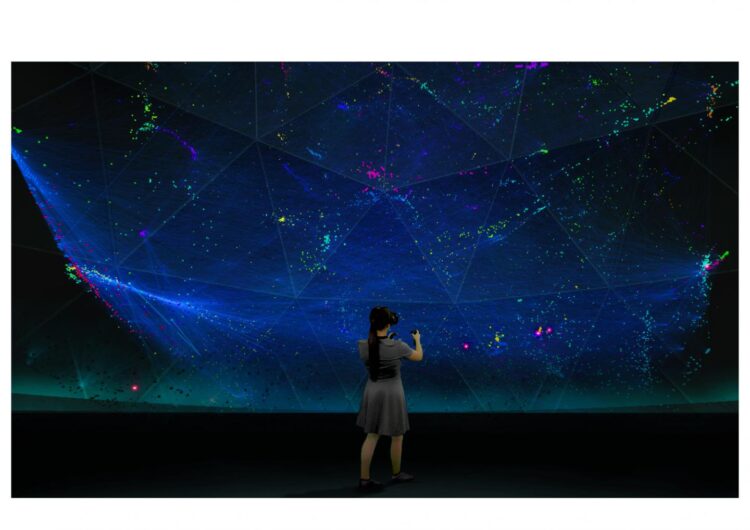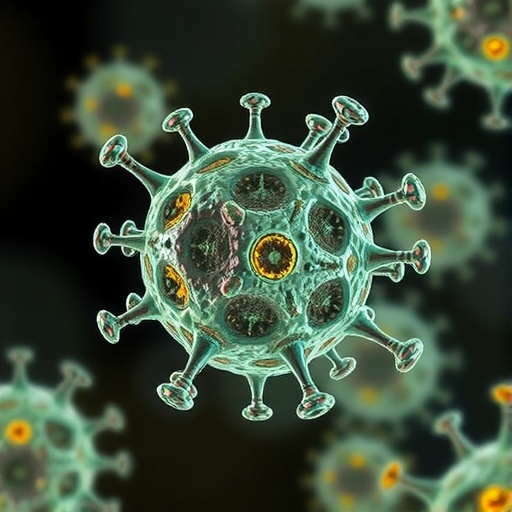A new VR platform enables the display of huge amounts of data. This can be helpful in the study of rare genetic defects, among other things.

Credit: Sebastian Pirch, published in Nature Communications 2021.
Networks offer a powerful way to visualize and analyze complex systems. However, depending on the size and complexity of the network, many visualizations are limited. Protein interactions in the human body constitute such a complex system that can hardly be visualized. Jörg Menche, Adjunct Principal Investigator at the CeMM Research Center for Molecular Medicine of the Austrian Academy of Sciences, Professor at the University of Vienna and research group leader at Max Perutz Labs (Uni Wien/MedUni), and his team developed an immersive virtual reality (VR) platform that solves this problem. With the help of VR visualization of protein interactions, it will be possible in the future to better recognize correlations and identify those genetic aberrations that are responsible for rare diseases.
The larger and more complex networks are, the more difficult their visualization on the screen becomes. Conventional computer programs quickly reach their limits. This challenge was addressed by network scientist Jörg Menche and his research group at the CeMM Research Center for Molecular Medicine of the Austrian Academy of Sciences. They developed a VR platform for exploring huge amounts of data and their complex interplay in a uniquely intuitive fashion.
The body as a network
The representation of complex data can be particularly important in the search for the cause of rare diseases, because the human body, with its approximately 20,000 proteins that are encoded in the human genome and interact with each other, represents a huge complex network. Whether movement or digestion – at the molecular level, all biological processes are based on the interaction between proteins. If the protein interactions are illustrated in a network, a barely representable picture of about 18,000 dots – proteins – and about 300,000 lines between these dots will be created. Menche and his research group used the virtual reality (VR) platform they developed to make this image “readable” and, in collaboration with St. Anna Children’s Cancer Research, succeeded in making the entirety of protein interactions visible for the first time. This makes it possible to interactively explore the vast and complex network.
Approaching the cause of rare immune diseases
For their study, published in Nature Communications, first author Sebastian Pirch and Menche’s research group identified connection patterns between different protein complexes in the human body and linked them to their biological functions. In addition, the scientists used global databases to identify specific protein complexes associated with a particular disease. “While conventional forms of representation would look like a proverbial ‘hairball’, the 3-dimensional representation enables the precise analysis and observation of the different protein complexes and their interactions,” says study author Pirch. This can be particularly important in the identification of rare genetic defects and crucial for therapeutic measures. “On the one hand, our study represents an important proof of concept of our VR platform; on the other hand, it directly demonstrates the enormous potential of visualizing molecular networks,” says project leader Menche. “Especially in rare diseases, severe immune diseases, protein complexes associated with specific clinical symptoms can be analyzed in more detail to develop hypotheses about their respective pathobiological mechanisms. This facilitates the approach to disease causes and subsequently the search for targeted therapeutic measures.”
About the VR platform
The platform developed by Menche’s research group is designed for maximum flexibility and extensibility. Key features include the import of user-defined code for data analysis, easy integration of external databases, and a high degree of design freedom for arbitrary elements of user interfaces. The researchers were able to draw on technology normally used in the development of 3D computer games, such as the globally popular game Fortnite. By publishing the source code, the researchers hope to convince other developers of the potential of virtual reality for analyzing scientific data.
###
The study “VRNetzer: A Virtual Reality Network Analysis Platform” was published in the journal Nature Communications on April 23, 2021. DOI: 10.1038/s41467-021-22570-w.
Authors: Sebastian Pirch, Felix Müller, Eugenia Iofinova, Julia Pazmandi, Christiane V. R. Hütter, Martin Chiettini, Celine Sin, Kaan Boztug, Iana Podkosova, Hannes Kaufmann & Jörg Menche
Funding: This work was supported by the Vienna Science and Technology Fund (WWTF) through projects VRG15-005 and NXT19-008, and by an Epic MegaGrant.
Jörg Menche studied physics in Leipzig, Recife and Berlin. He did his PhD with Reinhard Lipowsky at the Max-Planck-Institute for Colloids and Interfaces in Potsdam (Germany), and was a postdoctoral fellow with Albert-László Barabási at Northeastern University and at the Center for Cancer Systems Biology at Dana Farber Cancer Institute in Boston. He joined CeMM in 2015 as a Principal Investigator. In September 2020, he received a joint professorship at the Max Perutz Labs and the Faculty of Mathematics of the University of Vienna, and became CeMM Adjunct PI.
The mission of CeMM Research Center for Molecular Medicine of the Austrian Academy of Sciences is to achieve maximum scientific innovation in molecular medicine to improve healthcare. At CeMM, an international and creative team of scientists and medical doctors pursues free-minded basic life science research in a large and vibrant hospital environment of outstanding medical tradition and practice. CeMM’s research is based on post-genomic technologies and focuses on societally important diseases, such as immune disorders and infections, cancer and metabolic disorders. CeMM operates in a unique mode of super-cooperation, connecting biology with medicine, experiments with computation, discovery with translation, and science with society and the arts. The goal of CeMM is to pioneer the science that nurtures the precise, personalized, predictive and preventive medicine of the future. CeMM trains a modern blend of biomedical scientists and is located at the campus of the General Hospital and the Medical University of Vienna. http://www.
The Max Perutz Labs are a research institute established by the University of Vienna and the Medical University of Vienna to provide an environment for excellent, internationally recognized research and education in the field of Molecular Biology. Dedicated to a mechanistic understanding of fundamental biomedical processes, scientists at the Max Perutz Labs aim to link breakthroughs in basic research to advances in human health. The Max Perutz Labs are located at the Vienna BioCenter, one of Europe’s hotspots for Life Sciences, and host around 50 research groups, involving more than 450 scientists and staff from 40 nations. http://www.
St. Anna CCRI is an internationally renowned multidisciplinary research institution with the aim to develop and optimize diagnostic, prognostic, and therapeutic strategies for the treatment of children and adolescents with cancer. To achieve this goal, it combines basic research with translational and clinical research and focus on the specific characteristics of childhood tumor diseases in order to provide young patients with the best possible and most innovative therapies. Dedicated research groups in the fields of tumor genomics and epigenomics, immunology, molecular biology, cell biology, bioinformatics and clinical research are working together to harmonize scientific findings with the clinical needs of physicians to ultimately improve the wellbeing of our patients. http://www.
Media Contact
Anna Maria Schwendinger
[email protected]
Original Source
http://cemm.
Related Journal Article
http://dx.





